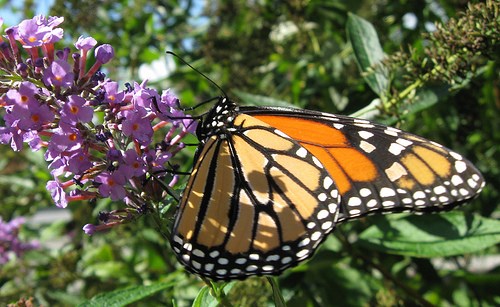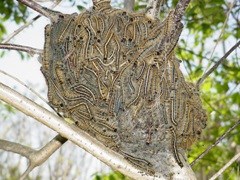
NPS photo Monarch Butterfly This striking orange and black butterfly is one of the most amazing travelers in the world. At the end of summer, these butterflies begin their southward migration. The Monarchs travel from their northern summer territories like Gateway all the way to Central Mexico, a journey of as much as 2,500 miles. In Mexico, Monarchs gather in the thousands to overwinter. The next spring, the butterflies begin the reverse trip, which spans several generations. Each generation of butterflies migrates northward as far as they can, then lays eggs. Then the next generation carries on as far as it can go, lays eggs, and so on, until the northern limit of their range is reached. Exactly how they manage this amazing journey has yet to be discovered. 
NPS photo Eastern Tent Caterpillar
Hundreds of black, hairy eastern tent caterpillars (Malacosoma americanum) with a white stripe and blue dots along the length of their bodies are inhabitants of Gateway Recreation Area during the spring season. They favor wild black cherry trees, which can be found at most of the Gateway sites.
During the winter, 100-300 eggs survive inside each black bulge encircling the twigs on the black cherry trees. The larvae develop inside the eggs, but do not hatch until the next spring. The eggs hatch when the tree's leaves start budding and the larvae feed on the new leaves while spinning their notorious "tent", which is commonly mistaken for spider webs. The tent is used as a feeding area and a resting place for the caterpillars. They transform - or pupate-inside the tent cocoon and emerge in the summer as moths to lay more eggs.
As you walk under the canopy of a black cherry tree, look closely for tent structures made by the eastern tent caterpillars. A great tool to bring along for this adventure would be a hand lens or a bug box. In the event that you find a caterpillar, remember to be gentle and to release it after your observation. These caterpillars are kind and not harmful so there is no need to be frightened.
Keep in mind that you should take only photos and leave footprints at a national park. No living species are to be brought home. Releasing the caterpillar will allow it to mature into a moth and lay more eggs for hatching next spring. You can return to the same tree this winter to visit the newly laid eggs that are found in the small black bulges on the twigs of the tree. |
Last updated: June 21, 2019
